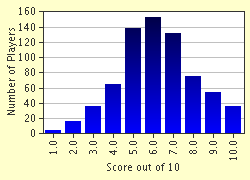Quiz Answer Key and Fun Facts
1. This German scientist shared the 1950 Nobel Prize for Chemistry.
2. When I wasn't achieving Ds in science, I was getting Fs! I'm going to combine D and F for a question - who is the scientist whose last name begins with F who invented the dynamo?
3. This man discovered the pain-relieving effects of nitrous oxide (laughing gas). Who was he?
4. The person who gives the weather forecasts on your local television station often refers to this for forecasting the weather in your area.
5. This ancient Greek scientist and mathematician discovered the physics principle of the density and buoyancy of water when he sat in his bathtub.
6. In 1925, a young American school teacher was put on trial for teaching this man's theories.
7. Where did Crick and Watson and their team do their work on deoxyribonucleic acid (DNA)?
8. What is a diatom?
9. Dimenhydrinate is the scientific name for a drug that is used to prevent - what?
10. Dendrochronology is the study of what?
Source: Author
Cymruambyth
This quiz was reviewed by FunTrivia editor
crisw before going online.
Any errors found in FunTrivia content are routinely corrected through our feedback system.

